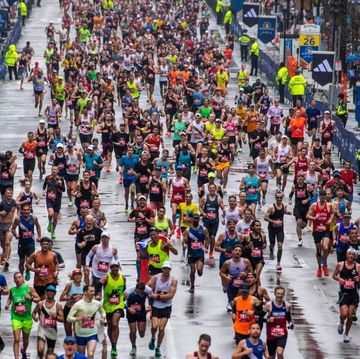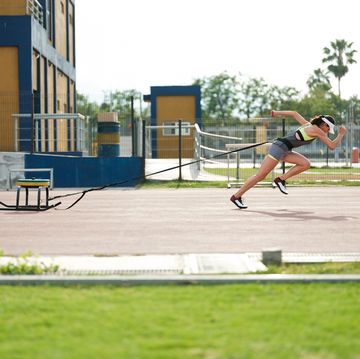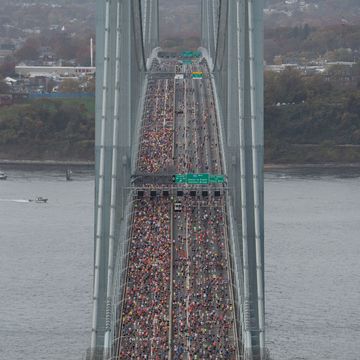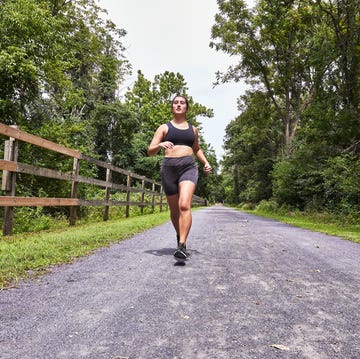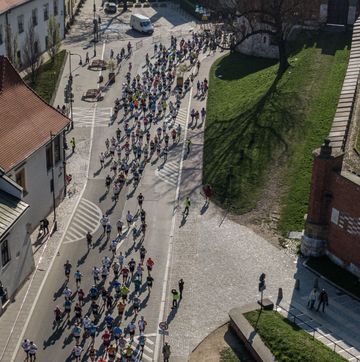In the summer of 2013, a then-36-year-old night pharmacist from Hamilton, Ontario, entered the Western States Endurance Run, one of the world’s most competitive 100-mile races. It would be the farthest he’d ever run—by 50 miles.
If he finished, the race would take him and the 276 other participants on a scrambling tour of the California high country. From the start at Squaw Valley, the runners would arc west through the Sierra Nevada, climbing some 18,000 total feet and descending 23,000 feet more, all the way into the town of Auburn on the outskirts of Sacramento. For the majority of the field, the most sought-after prize is a belt buckle earned for finishing in 24 hours.
Barely 15 hours after the athletes disappeared into the mountains, the pharmacist, Rob Krar, came running into view outside the finish at the Placer High School track. He had second place firmly in hand, a mere 4 minutes and 38 seconds—the ultramarathoning equivalent of a photo finish—behind two-time champ Timothy Olson.
“I have no idea where those 15 hours went,” Krar says. “I was just a totally different being.”
His obscure racing history made the feat all the more confounding. There wasn’t much evidence of his running before Western. He’d competed on an athletic scholarship at Butler University and notched a 2:25 at Boston, but these were footnotes rather than explanations. Traditionally, ultra has had about as much to do with track and marathoning as downhill skiing does with Nordic, although crossovers have become less rare. Krar’s Grand Canyon Rim-to-Rim-to-Rim FKT (or fastest known time, a world record of sorts for the trails) that spring may have turned some heads, but the canyon’s 42 miles didn’t prove he’d survive 100.
Two weeks prior to that Grand Canyon crossing, Krar had competed in his first 50-miler at the Leona Divide race. He won, broke the course record and earned automatic entry into Western States.
“He just jumped in the most competitive 100,” Olson says, acknowledging Krar’s decision to race Western, which came only eight weeks before the start. “Definitely insane.”
Fans and other runners were hesitant to write it off as a fluke; like open-ocean sailing or free climbing, there’s not a lot of beginner’s luck in ultramarathoning. The distance is defined as any race longer than 26.2 miles; the real ultra racing, according to die-hards, happens after 60 miles, when—not unlike a mountaineer climbing in the “death zone”—the runner is slowly dying.
To lace up for Western is to enter running lore itself—the race’s origins are as peculiar as the breed of people dotting its trails. Originally the world’s pre-eminent horse endurance challenge, Western States Trail Ride got its first two-legged competitor in 1974 when Gordy Ainsleigh finished the race. By 1977, 14 men ran in the world’s first 100-mile footrace, and eventually more feet than hooves toed the starting line.
Western would remain Krar’s sole loss for 2013. He went on to win his next three races before hanging it up for the season in early December. In a year that he completed his first 50-miler, then first 100 at Western, he won five races and set two course records, collected $15,000 and bested most of his competition by margins of time almost seismic. UltraRunning magazine named Krar its Male Ultrarunner of the Year.
The North Face offered him a professional running contract last fall. Between training and race appearances, it has amounted to a second job, one he juggles between 10-hour graveyard shifts at a local pharmacy.
Unlike many professional runners, who often must acclimate to fame at a young age, Krar had lived most of a normal adult life—doctorate, career, house, marriage—before ever seeing his name in print. Already self-effacing, he met the onslaught of attention with a series of bashful quips. During dinner at home one evening in the early spring, a plaque for Canadian Ultrarunner of the Year arrives with his picture. He palms it like a cheap trinket and files it absentmindedly behind the KitchenAid mixer, wondering aloud if a picture of him and his wife might fit in the frame.
Krar’s reticence at first fit snugly into the idea that he’d come from out of nowhere, a nearly middle-aged wunderkind. More Benjamin Button than Bobby Fischer, Krar shared in everyone’s surprise, responding to post-race interviews with clipped astonishment. Golly, it’s just great to be here—yeah, as puzzled as you.
But by March of this year, Krar has eased off the aw-shucks humility. Speaking from the townhouse he and his wife, Christina Bauer, share in their adopted hometown of Flagstaff, Arizona, he says that, sure, the attention was flattering, but the whole out-of-nowhere bit? That was just another part of the ride—he knew he could compete well if he found his niche in the sport.
Krar avoids or coyly dodges every question about why he races ultras. Why he races at all, in fact. Because if it wasn’t from out of nowhere, then where has it all come from?
Later that day, Krar runs some errands downtown, the snow-dusted peak of Mount Elden rising 9,299 feet in the background. Dropping by Run Flagstaff, the local running store, Krar chats with some buddies and, raising his eyebrows, nods over at the wall. Above the shoe racks, the owners have painted Krar and his now-famous beard, silhouetted against him like a great fuzzy lobster bib, into their hall-of-fame mural. Pointing out each runner in turn, Krar lands on himself last and says, “And. There. I. Am.” The man and the image of the man, side by side.
Krar grew up the younger of two boys in Hamilton, Ontario, a city southwest of Toronto. Larry, his father, taught elementary and middle school. His mother, Carolyn, worked as a nurse. It was a tightknit, middle-class family, which Krar dismisses with a wave of his hand: “normal, happy.” Krar began training for triathlons in high school and at 16 made the Canadian national team, traveling to New Zealand to race in the world triathlon championships in 1994.
Like many Canadians, the Krars hoot out their OUs. When one speaks, the other “mm-hmms” with approval. Recently retired and living in the Okanagan Valley in rural British Columbia, Rob’s parents are delightfully flummoxed about his success and, search as they might through his past, they can’t account for its origins. They alternately describe Rob as serious, gentle and free-willed. “Holy smokes, he can be very stubborn,” says Larry, who now does volunteer maintenance on a system of snowshoe trails he helped develop. “Rob’s never had a leader,” Carolyn quickly adds.
At Butler, Krar focused on middle-distance and ended up training alone a lot. “I’d run a fast 800 during winter track my freshman year,” he says, “so I got designated a middle-distance guy.”
After studying biology his freshman year, he entered pre-pharmacy and was accepted into the rigorous doctor of pharmacy program late in his sophomore year. Friends warned him he couldn’t run and succeed academically. “Hearing that,” Krar says, “my stubbornness was responsible for me picking pharmacy as much as anything else.”
He graduated with what he felt were only modest PRs (1:51 for 800m; 3:44 for 1500m). Taking a well-paying job with Walgreens, Krar left Indiana in 2002 and settled in Phoenix. He was soon assigned to the night shift—9 p.m. to 8 a.m., seven days on, seven days off—a schedule he’s now worked for more than a decade.
He signed a three-year contract, but things quickly fell apart. Krar and his longtime girlfriend broke up, and he loathed Phoenix. He barely ran for nearly three years.
Slowly stirring his double cappuccino in downtown Flagstaff, Krar has all the trappings of the hipster mountain man—flannel, turquoise ear gauges, Subaru out front—but he’s rail thin. You can see down to his elbows when his cuffs are buttoned. At 5-foot-8, 130 pounds, with hazel eyes, Krar looks, most of the time, stoically amused. Only occasionally does he broaden his face, unearthing a mischievous smile.
And the beard? You could imagine a lot of old metal-heads raising a glass. But the thing’s just wiry enough that you get flickering projections of the handsome jawline below.
Historically, ultramarathoners have been built for the workload, more loggers than trail runners. But Krar—chest thrust out, slight frame, pitter-pattering up on his toes—is more like a beach extra in “Chariots of Fire.” He’s rigid in the shoulders and back, but pliant and springy below the belt. Watching his size 8.5 feet glance off rocks, there’s something of an Irish dancer in him.
Krar’s rep around town pegs him as even-keeled, the model Canadian—all alpha waves and positive vibes. Mike Smith, Krar’s old roommate in Flagstaff and now the women’s cross country coach at Georgetown University, says as much: “You watch Rob play with his cats—listening to Natalie Merchant and Indigo Girls when he works out—just a soft soul.”
In conversation, Krar wanders through topics, darting suddenly when curiosity strikes, then turning a subject over and over again. Almost excessively deferring, he’s careful to keep a healthy conversational ratio. When he does commandeer a subject—like climate change or sports agents (Krar represents himself)—his questions typically outnumber his opinions.
To some degree, Krar’s centeredness is typical for an ultrarunner. Like the Sierra Club hosting a Burning Man fun run, ultras attract their share of hippies and weirdos, basically anyone groovy enough to chance kidney failure or losing all their toenails for a shot at a most excellent runner’s high. Christopher McDougall, in his bestselling book, Born to Run, compared one group of ultrarunners to beatniks: “... poor and ignored and free from all expectations and inhibitions.”
Like other subcultures, ultrarunning is, at its heart, a crucible, a place that feeds a deeper kind of addiction. Timothy Olson’s pitch was simple—and unwittingly literal: “It’s so dope, dude.”
Against this backdrop, it’s easy to see how Krar has come to embrace more of the “bearded mystique,” as his folks call it. And yet, unlike his compatriots, Krar doesn’t appear particularly afflicted, or even that battle-hardened. In fact, it seems Krar has become better at competing at exactly the same rate as his personality relaxes.
In December 2005, Krar moved to Flagstaff, a mountain hamlet famous as a runner’s haven, thanks to its blood-thickening 7,000 feet of altitude. There, Krar ventured into the Painted Desert and Grand Canyon, tagging along on runs with local pros like Smith and Alicia Shay, now a member of the Nike elite trail team. The idea of running a marathon elbowed itself into his mind in early 2007, and he ran 100 miles that week. A 2:25 at Boston, as well as a 1:06 half in Toronto, showed some promise of a pro career, but injuries and his odd sleeping schedule soon took their toll. He stopped running, again.
A little more than a year later, in December 2008, Smith called Krar and asked him to do TransRockies, a six-day team stage race covering 120 miles from Buena Vista to Beaver Creek, Colorado. Smith wasn’t sure that Krar would agree, but he did. On the spot.
The race would turn out to be traumatic. “It destroyed my mind and body for a long time,” Krar says.
On the way to Colorado, Krar revealed to Smith that he hadn’t been running in about a week. “My sciatic nerve was acting up,” Krar says. “My heels hurt really bad. I could barely walk.”
Smith was ready to pack up and go home, but Krar pleaded with him to line up anyway. Five miles in, Krar looked to be moving along, albeit slowly, so Smith relaxed.
Secretly, each stage proved to be a nearly unnavigable labyrinth of pain for Krar. “I remember lying down in a meadow,” he says, “just staring up.” By then, they were well into the race’s lead, but Smith was worried. He was physically pushing Krar up the later climbs. Near the finish, Krar’s back finally gave out. His left leg seized up completely, and he was forced to drag it the last half-mile. After winning, he went straight to the emergency room.
In the spring, several months after TransRockies, Krar’s sciatic nerve had finally healed, but he now needed surgery to repair Haglund’s deformities on both heels (painful bony growths that push out on the Achilles). “I scooted around the house in kneepads for a couple days,” Krar says.
Smith knew this period was hard on Krar. But how hard, it was difficult to say. “He’d never complain,” Smith says. “But when he’d watch me leave for a run … I just felt really guilty.” There wasn’t much anyone could do, either. “If something was ever wrong with Rob,” his mother, Carolyn, says, “he’d never tell us.”
The only highlight of the episode was that Krar began seeing Christina Bauer, a fellow competitor at TransRockies, and his infirmities meant he could spend more time traveling to visit her in Salt Lake City. Bauer, then a special education teacher, introduced Krar to ski mountaineering and rock climbing. He picked up fly-fishing. They went winter camping on one of their first dates.
Long-limbed with an easy laugh, Bauer is carefully composed. Her outdoor résumé reads like something out of Edward Abbey. Krar confesses he grew the beard to impress her. “We both just knew right away,” Bauer says. Instead of rings, they tattooed their feet as symbols of their union: Bauer, a sego lily; Krar, an aspen grove near a snowy peak.
At the time, Bauer didn’t think about Krar as a runner. “I knew he ran,” she says, “but I only heard stories about his intensity.”
Krar likes to spend his winter evenings ski mountaineering up Arizona Snowbowl, a ski resort just outside Flagstaff. With spring flurries huddling around him during a March outing, he heads up the slope.
By necessity, Krar’s mileage during workweeks stays relatively low, around 75. Krar runs more during his off weeks, as much as 110 miles, which he does entirely by feel. He has no coach. “I don’t know why I write down my mileage,” he says. “I’ve never looked at it.”
Once a week, Krar throws in a workout, usually long repeats at 5-minute pace. Most days he runs on singletrack mountain trails and service roads, but occasionally he ventures to the Grand Canyon for a “quad-burner.”
Unlike many of his competitors, Krar doesn’t log his “vert,” or vertical gain, for the week, but he does his homework when it comes to fueling and preparing for key races on the schedule. This year, he’s planning on Western States and the North Face Endurance Challenge Championship.
Krar’s training philosophy is the result of molding his running to the contours of his work schedule. It also stems from his numerous setbacks—especially in the aftermath of the 2009 TransRockies race. “That retrospective of defeat is something I never want to revisit,” he says, adding, “All that time off: whew.”
So he did away with weekly mileage quotas, dropping the rigidity. Krar wants to ensure that each morning, day after day, he is able to wake up and, regardless of the intensity, get in a run. Or at least not lose weeks and months to injury. “I’m not afraid of the days off,” Krar says.
If his new approach meant compromising a few minutes off the top of his potential, fine. “I don’t risk the razor’s edge anymore,” he says. “The consequences of reaching for those last few [percentage points] of performance just aren’t worth it.”
That this plan has made him a worldbeater was a surprise that he shares in with everybody else. He smirks at the irony but preaches his philosophy like gospel.
By the time Krar reaches the top of the ski slope, it’s dark. Icicles hang from his beard. He doesn’t rest long. After a gulp of water, he peels the skins off his skis, locks his bindings in place and plunges back down the mountain, into what is now a whiteout.
In February 2012, more than two years after TransRock-ies, Krar got the urge to run again. Some friends entered Red Hot, a 33K trail run in Moab, Utah, and Krar decided to test out his heels and back. He’d been ski mountaineering to build fitness and figured if he took it easy his body would hold up. He won the race, broke the course record and in early March started running again in earnest.
Athletic confidence has always been like a snowball, amassing strength slowly over distance and time. Krar remembers a moment when his emerged whole, for a time, prior to his latest comeback. Smith was there, that day in the Grand Canyon.
“It was always high anxiety when you enter the park,” Smith says of his shared experiences with Krar. “Hands shaking, no talking. You park the car, go to the bathroom, shed the layers. It’s freezing. It’s dark. You go up to the rim. It opens up before you like you’re skydiving. Rob says, ‘I can’t do it,’ goes off in the bushes and just starts crying. Then he walks back over and says, ‘Let’s go,’ and, whoosh, we drop in.”
There’s no way out of the canyon. Whatever you get yourself into, you’d better be prepared to get yourself out. When Krar made it out his first time, he felt he was ready for anything.
By the next fall, Krar had set a new Rim-to-Rim FKT (which still stands, set prior to his double-crossing record) and represented Canada at the World Mountain Running Championships in Temù, Italy. After a decade of false starts, Krar had finally put together a full season. The question now was, how hard could he push it?
Writer Haruki Murakami, himself a dedicated marathon-er, once described running a 60-plus-mile race as going “into a blank state you might even call philosophical or religious.” Murakami said he was never physically nor mentally the same after finishing.
Krar had never heard of Murakami’s experience, chronicled in What I Talk About When I Talk About Running, but he says for him, it’s not a blank state. It’s brimming with pain. Ultras force you onto a hyperaware, hyperfocused plane. “I don’t meditate; I don’t practice any faith,” he says, pausing, suddenly embarrassed by his dramatic tone. “I get into this state where I’m intensely focused on my body, my breathing.”
His mouth curls at the corners: “I just love making myself hurt.”
Krar explains that races aren’t about competitors. They’re about reaching inside and feeling out the seams of his character.
“I love, I love, I love going to that dark place at the end of a race,” he says.
Recently, at the Lake Sonoma 50, with less than 5 miles to go, Krar reeled in Sage Canaday to grab second. But that’s not what had him jazzed after the race. “I had probably my worst patch ever in an ultra,” he says, “from just after midway to about 5 miles to go—just damn miserable.” Krar called the race “fascinating.”
This kind of dark place is accessible in races like Lake Sonoma, where the real depths of suffering reveal themselves.
He calls that place “the Cave.”
What’s inside the Cave?
Krar’s euphoria suddenly buckles. Tears pool in his eyes.
“I’ve struggled with depression for a long time,” Krar says. “I guess it started sometime in college.”
He simply wrote the episodes off as stress. Even later, as a clinician, Krar still didn’t perceive his suffering as anything more serious, all the while administering prescription drugs to clients in similar pain.
“I tried not to put much thought in it,” he says, “but it got so bad it was very obvious.” He’d lie in bed for multiple days in a row. “No matter how much you want to deny it, it gets to a point where, yup, yup, something’s fucked up here.
“I’ll do my best to try to fight it off,” he says, “but it almost feels good now. I just accept it and crawl in bed.” He says it will probably worsen as he ages.
What it is exactly, he doesn’t know. Despite his intellect, Krar is generally resistant to self-analysis. “I don’t understand it,” he says, “which is the frustrating part.”
Krar walks back through his past, pointing out potential culprits, but denies any kind of manifesting trauma. To him it’s just bad brain chemistry, and he hasn’t sought treatment.
He speculates about the clangor of modern culture and the downward spiral of the environment and how they probably contribute to his depression. “I’m thinking about everything and nothing at the same time,” he says.
Bauer feels Krar is simply too hard on himself, allowing all that “everything” and “nothing” to go on infinite spin cycle. She thinks perhaps one day her husband could benefit from therapy (she’s a school counselor), but she knows running helps. When he’s able to go out and punish himself on the trails, he’s a better man and, he feels, a better husband.
Smith agrees that running makes Krar better, but in a more tangible way. “Regardless of what’s haunting him, you have to race that dark side. And good luck, because when you’re beside him, sawing away at a mountain, there is a very cold, hard side of that dude. It’s terrifying,” he says. “He’s like a killer.”
“No doubt,” Krar says. “I wouldn’t be winning these races without that dark place.
“I wouldn’t wish it upon anyone else, because it’s suffering,” he says, his voice growing more defiant, “but when I race, I sink hard in the hole, and I want to be there.”
The next morning, after seeing Bauer out the door, Krar stretches for his morning run. Fleet Foxes harmonize softly as his cats, Bee and Mo, both rescues, mew around his feet. There is a demanding workout on the day’s docket, more than 10 miles of race-pace repeats over undulating trails. But Krar doesn’t dwell on the coming onslaught. “I don’t get nervous anymore,” he says, rolling a tennis ball back and forth under his foot.
It’s 10 a.m. Time to go.
Krar strips down to his shorts, laces up his minimalist shoes and pecks at his watch. In silence, he jogs up to Buffalo Park, a system of gravel trails spread atop a grassy mesa, a favorite workout spot among area pros. A dusting of snow covers the ground.
An hour later, as the desert sun climbs to its meridian, Krar bursts into his final repeat. The snow is gone. He tosses his long-sleeve shirt in the grass. The mountain air comes cool and rich with juniper.
Curving away from the mountains, the trail uncoils into a parallel line under the horizon. Hovering along it, his figure framed in miniature against the sky above, Krar works his legs in tight, jabbing steps. Ahead, the trail descends into a steep gulch tucked among ponderosa pine.
Krar opens up, hammering into the downhill. As he dips below the skyline, he appears, for a moment, cut in half at the waist. Then he disappears completely.






